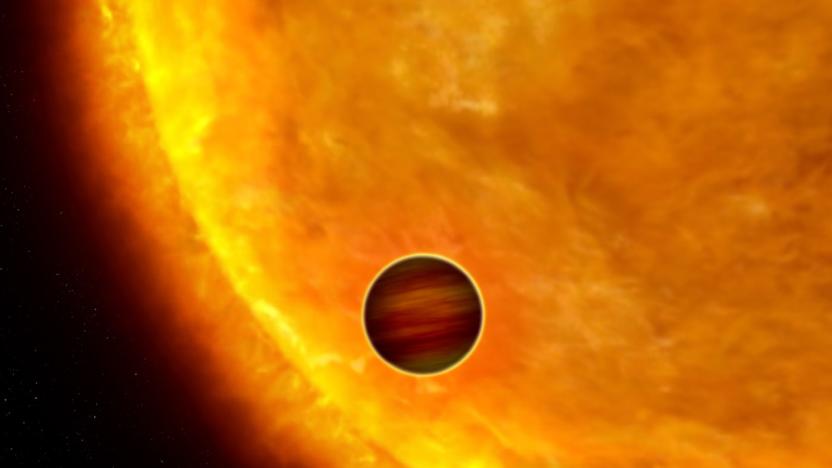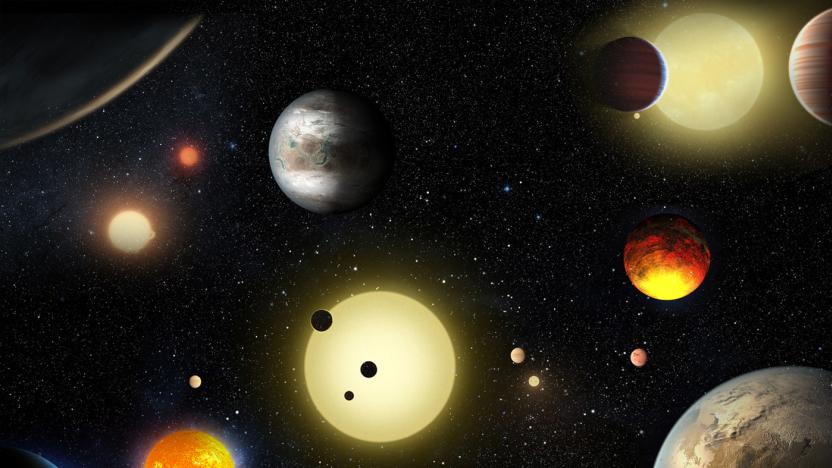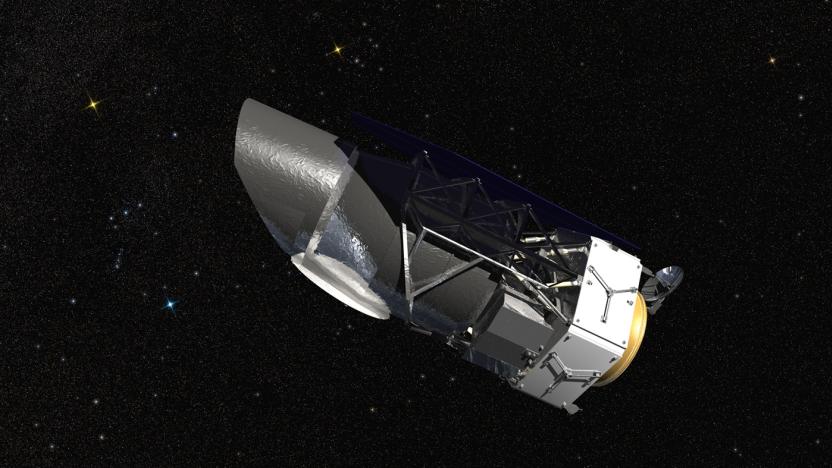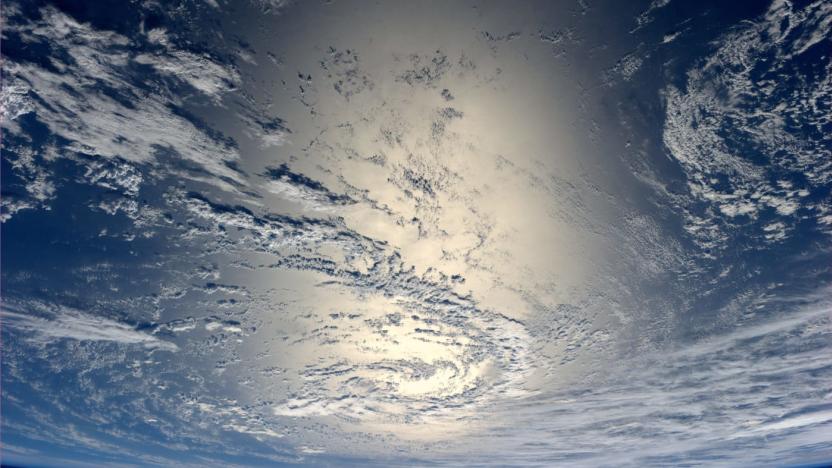exoplanet
Latest

Hot Jupiter planets can speed up their stars' rotation
Hot Jupiter exoplanets are the farthest thing from habitable, but that doesn't mean they're boring. Scientists from Princeton University and elsewhere have discovered one that is so large and close to a star that it actually changes its rotational speed. Called HATS-18 after the main telescope (HATSouth) used to discover it, the planetary system is about 2,100 light-years away. However, it's ridiculously near its star (closer than Mercury is to our sun) and huge, at 1.34 times the size of Jupiter, so it completes an orbit in less than an Earth day.

Kepler telescope finds its largest-ever batch of planets
If you think the Kepler space telescope has already spotted a lot of exoplanets, you haven't seen the half of it... almost literally. After a lot of hype, NASA's Kepler team has verified the existence of 1,284 new planets. That's more than twice as many confirmed planets as before. Almost 550 from the new batch are big enough to be Earth-like rocky planets, while nine of them are in their host star's habitable zone and have the potential to support life.

'Starshot' plan gets probes to Alpha Centauri in your lifetime
The concept of exploring other star systems with probes (and not just telescopes) has proven elusive for one good reason: even the fastest spacecraft would take 30,000 years just to reach Alpha Centauri, our closest neighboring star. However, investor and space project enthusiast Yuri Milner thinks it's possible to do better. He and physicist Stephen Hawking have launched Breakthrough Starshot, a $100 million program that aims to get probes to Alpha Centauri within a generation. If all goes well, the observers would reach the relatively close-by system (4.4 light years away) within 20 years of leaving Earth.

NASA is building a new exoplanet-hunting tool
NASA and the National Science Foundation (NSF) are done forming the special team of astronomers to build their new, powerful exoplanet hunter. The scientists were selected after holding a national competition and will be led by Penn State University assistant professor Suvrath Mahadevan. They'll now spend the next three years building the $10 million instrument called NN-EXPLORE Exoplanet Investigations with Doppler Spectroscopy (NEID) for the joint project. Once it's finished, the instrument will be installed on the 3.5-meter WIYN observatory (pictured above) at the Kitt Peak National Observatory in Arizona.

NASA's next space telescope sees 100 times more than Hubble
As much as the Hubble Space Telescope has done to shine a light on the darkest corners of the universe, it doesn't hold a candle to what's coming next. NASA has started work on WFIRST (Wide Field Infrared Survey Telescope), a space observatory with a field of view 100 times larger than that of Hubble -- if the old telescope was a porthole, the new one is a giant window. It's also designed to block the glare of individual stars, making it easier to determine the chemical makeup of exoplanets.

ICYMI: NASA's new telescope, amazing robot hand and more
#fivemin-widget-blogsmith-image-777419{display:none;} .cke_show_borders #fivemin-widget-blogsmith-image-777419, #postcontentcontainer #fivemin-widget-blogsmith-image-777419{width:570px;display:block;} try{document.getElementById("fivemin-widget-blogsmith-image-777419").style.display="none";}catch(e){}Today on In Case You Missed It: NASA just started developing the Wide Field Infrared Survey Telescope, slotted to hit space by the mid-2020s. This will good 'ole Hubble still chugged away, analyzing the atmosphere of an exoplanet 40 light years away. University of Washington developed a robotic hand capable of carefully holding small, delicate objects by first 3D printing a hand based on a human skeleton, then adding tendons and muscles just where a person's would be. For those of you with any difficulty typing, this DIY creation pairs speech recognition with mechanical buttons for some riveting viewing. If you didn't read it, make sure to dive into the Apple vs. FBI debate here. As always, please share any interesting science or tech videos, anytime! Just tweet us with the #ICYMI hashtag to @mskerryd.

Exoplanet census suggests Earth really is special
There are an estimated 700 million trillion terrestrial planets in the observable universe. Among them, Earth may very well be one of a kind according to a new study from Uppsala University in Sweden. Astronomer Erik Zackrisson and his team have been running computer simulations to model all of the terrestrial planets that are likely to exist in the universe. The probabilistic exoplanetary statistics that they've gleaned from these simulations could potentially upend the Copernican principle and will soon be published in The Astrophysical Journal (it's currently up on arXiv).

ICYMI: Pigeon cancer detection, pill stethoscope and more
#fivemin-widget-blogsmith-image-362475{display:none;} .cke_show_borders #fivemin-widget-blogsmith-image-362475, #postcontentcontainer #fivemin-widget-blogsmith-image-362475{width:570px;display:block;} try{document.getElementById("fivemin-widget-blogsmith-image-362475").style.display="none";}catch(e){}Today on In Case You Missed It: Researchers were able to train pigeons to choose whether medical images contain a benign or malignant tumor with 99% accuracy. MIT scientists made a biomonitoring pill that patients can swallow to collect their pulse, breathing rate and internal temperature. And musicians have a new option in the form of the tiny Motus instrument, which recognizes shaking and twirling to create music out of movement.

NASA's chemical 'laptop' would help find life on other planets
Planetary rovers can already find potential signs of life, but they're not really meant to find life itself. NASA may have just the device to find that concrete evidence, though. Its newly tested Chemical Laptop is the first device built to detect amino acids and fatty acids (the telltale signs of life as we know it) on other worlds. The battery-powered device needs liquid samples to work, but it has a coffee machine-like mechanism that uses hot water to get the organic material out.

Scientists chart Mach 7 winds on a Jupiter-sized exoplanet
When scientists discovered a Jupiter-sized exoplanet in the Vulpecula constellation, they knew the weather there wasn't great. That's because HD 189733b orbits its star every 2.2 days at a speed of 341,000 mph and has an average surface temperature of around 2,240 F. A team from the University of Warwick in the UK has now made a rough weather map of the body -- the first ever for a planet outside our solar system -- and that news ain't great, either. Using the High Accuracy Radial velocity Planet Searcher (HARPS) instrument located in Chile, the team calculated that winds on HD 189733b rage at 5,400 mph, or seven times the speed of sound.

Astronomers find the first planet known to orbit a white dwarf
It's virtually certain that some white dwarfs still have planets in orbit despite their violent histories, but seeing those planets has proven difficult... at least, until now. Astronomers using the Kepler space observatory have spotted a planet circling around WD 1145+017, a white dwarf 570 light years away. Not that it's in great shape, mind you. The unusual light signature from the dying star hints that the planet is disintegrating under the star's gravitational pressure, leaving behind a giant dust cloud. Researchers suspect that it fell into its fatal orbit after the star's rapid change in mass triggered a planetary collision.

The majority of Earth-like planets haven't been born yet
Humanity's inability to find Earth-like planets may not be the result of limited technology or a lack of ambition -- we might simply be too early, and in the wrong place. Astronomers poring over Hubble and Kepler data now believe that only 8 percent of the universe's potentially habitable planets exist. Based on the amount of hydrogen and helium gas left over from the Big Bang, there's still plenty of opportunity for those planets to form. These planets are most likely to appear in either dwarf galaxies or giant galaxy clusters, where the stars haven't used up all the surrounding gas.

'Astroneer' is a planetary exploration game on a grand scale
Games like Kerbal Space Program are great at depicting the challenges of getting to another planet, but there isn't usually much to do when you arrive beyond planting a flag. Wouldn't it be nice to really, truly explore those alien worlds and make them your own? System Era may just give you that chance. Its upcoming Astroneer has you exploring and harvesting resources from vast, procedurally generated planets. You not only have to brave hostile conditions (including The Martian-like storms) and build up your base, but shape the very surface you're walking on. You can level hills, carve out tunnels and dig out artifacts buried in the soil -- think of it as Minecraft in an unfamiliar, unforgiving landscape.

Here's your clearest look yet at an alien planet in motion
That pixelated dot you see above may not seem like much, but it's a pretty big deal -- it's your best look yet at an alien world. Scientists have used the Gemini Planet Imager to capture the movement of Beta Pictoris b, a gas giant traveling around a star 60 light years away. That's no mean feat when the exoplanet is about a million times fainter than its host, requiring that the Imager block the star's light and compensate for the distortion of Earth's atmosphere. The visuals are important beyond bragging rights, we'd add, since they'll provide more insight regarding both the planet's composition and its relationship to nearby objects. Although it's going to be a long, long while (if ever) before you get clearly recognizable snapshots of an exoplanet, this abstract imagery has more than enough to keep scientists busy. [Image credit: M. Millar-Blanchaer/Dunlap Institute, F. Marchis/SETI Institute]

Exotic quantum laser could help study other planets
Scientists might soon have a much easier time discovering every last nuance of other planets. Researchers have developed a quantum cascade laser (which sounds like an amazing sci-fi weapon, by the way) that can cover a very wide range of infrared wavelengths at the same time, making short work of detecting many chemicals. Astronomers, including study backer NASA, could use it to determine the contents of a planet's surface without touching it -- important when you'd rather not risk breaking samples, or when it's not possible to touch down on the surface in the first place.

Younger version of Jupiter provides clues to planet formation
It's likely not the first time you'll hear scientists compare an exoplanet to Jupiter. According to a team of astronomers, though, this one called the 51 Eridani b isn't only similar in size -- it's "very much what models suggest Jupiter was like in its infancy." 51 Eri b, which has an atmosphere rich in methane, was spotted using the Gemini Planet Imager's new instrument mounted on the Gemini South Telescope in Chile. The instrument is as big as a small car, was made to filter out atmospheric turbulence and was optimized to spot faint planets next to bright stars. This exoplanet, for instance, is a million times less luminous than its host star, which is only 20 million years old or so; our own sun is already 4.5 billion years old.

Telescope filter helps spot Earth-like alien worlds
In the hunt for planets around distant stars, the stars themselves are often the worst enemy. They're so bright that you rarely spot anything smaller than a gas giant, which isn't much help when you're trying to find habitable worlds. An alliance of American and Dutch researchers may have the ticket to locating Earth-like bodies, though. They've developed a new variety of coronagraph (a telescope filter that blocks starlight) powerful enough to give a much better view of the objects around stars, even when they're half as far from their hosts as Earth is to the Sun. The key is that it doesn't block light directly, like other coronagraphs -- it instead has the light waves cancel each other out, even in the infrared wavelengths where stars tend to blot out their orbiting companions.

NASA forms a coalition to look for life on other planets
NASA knows that it can't rely solely on astronomers and robotic rovers to find life on other worlds, so it's recruiting some help. The space agency has formed the Nexus for Exoplanet System Science (NExSS), a coalition of scientists who study astrophysics, Earth, other planets and the Sun. The group will use its collective knowledge to search for alien lifeforms using perspectives that NASA wouldn't always have -- how does the loss of atmospheric chemicals affect the chances for life, for example? NASA hopes that the group will not only determine the habitability of planets, but develop technology to study those planets in greater detail. There's no guarantee that NExSS will discover organisms, let alone organisms that you might see within your lifetime, but the odds of success are now a bit higher. [Image credit: NASA]

NASA thinks we'll find signs of extraterrestrial life in 20 years
The quest to find proof of life beyond Earth hasn't been without its setbacks, but NASA isn't deterred. If anything, it's optimistic -- Chief Scientist Ellen Stofan now claims that there will be "definitive evidence" of extraterrestrial life within the next 10 to 20 years. Given the sheer number of oceans within just our solar system, she argues, it's "not an if, it's a when." The more pressing questions are what kind of life we'll find, and how we'll find it. It'll most likely involve a probe or rover detecting microscopic organisms rather than a close encounter of the third kind, so there probably won't be much drama involved. Still, the very fact that we could find alien species within our lifetimes is exciting. [Image credit: Lynette Cook, NASA]

Gas planets can become habitable if their stars get grabby
It's tempting to think of gas planets as permanently hostile to life as we know it. A pair of University of Washington researchers beg to differ, however. They've used computer modelling to determine that these worlds can become habitable when their stars get particularly grabby. If a relatively small, solid-core gas planet orbits a class M dwarf, tidal forces can tug it into a habitable zone and not only wipe out the gas (through the dwarf's X-ray and ultraviolet radiation), but produce life-giving water from the core's ice. Provided the timing is right, the result could be downright Earth-like.




